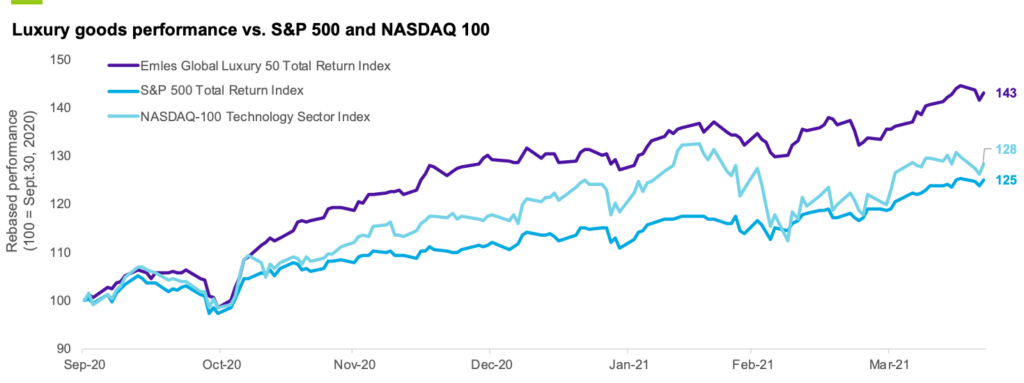The opening up of economies around the globe has unleashed pent up appetite for luxury goods. LVMH, the French luxury group often considered to be a bellwether for the category, recently reported a 30% jump in organic sales during Q1 2020,1 excluding the acquisition of Tiffany & Co. Revenue at its core fashion and leather goods division was especially strong, growing 52% year-on-year, far outpacing analyst consensus of 30%.2
The rebound in demand was so strong that LVMH’s Q1 2021 sales exceeded pre-COVID-19 first quarter of 2019 by 8%,2 surpassing the 17% gain some Wall Street analysts had expected for the quarter,3 LVMH share prices (Ticker: MC FP) have posted strong gains year-to-date in response, up 24%.4
Strong rebound in demand has reverberated throughout the luxury ecosystem. Luxury vehicles, for example, had a particularly strong first quarter: Lamborghini reported all-time record Q1 deliveries this year, equivalent to 25% and 22% increases vs. the same period in 2020 and 2019, respectively.5 In the same period, Mercedes-Benz deliveries were up 16% from the first quarter of 2020.6 Various luxury categories such as watches,7 home goods,8 and others have reflected these trends in their recent earnings reports.
Luxury goods have delivered strong returns
The surprisingly robust quarter for luxury brands demonstrates why they present compelling opportunities for investors. Consider the performance of luxury goods stocks. Since September 30, 2020, the Emles Global Luxury 50 Index has returned 43%, exceeding the returns of the S&P 500 by 18 percentage points. Luxury goods stock also outperformed U.S. tech stocks in the same time period by 18 percentage points.

Source: Bloomberg, Emles Advisors LLC calculations, as of April 21, 2021. Past performance is not a guarantee of future results. One cannot invest in an index.
China is driving growth in the global luxury market
Last year, Chinese consumers accounted for 35% of the world’s spending on luxury goods.9 By 2025, that share is expected to climb to 40%, nearly double China’s share just a decade ago.9 That pace of growth means that China is quickly becoming the world’s biggest market for luxury brands.
Younger generations are expected to continue to drive that growth. Bain & Company’s analysis of Alibaba’s Tmall, an online platform to sell brand name goods to consumers in Greater China, indicates that Millennials comprise 70% of the site’s luxury fashion segment. Millennial and Generation Z spend at Tmall is growing quickly, increasing 24% and 33% per year, respectively, outpacing overall luxury sales growth at Tmall. As these younger generations enter peak earning years, their appetite for luxury goods should help spur further growth for the sector.
In the brick-and-mortar world, Chinese consumers abroad have historically been an important growth engine for high-end fashion boutiques in London, New York and Paris. With international travel stopped last year, the Chinese government promoted duty-free shopping on the offshore islands of Hainan to help offset the impact of the limitations on travel on the luxury goods business. As travel restrictions loosen globally, luxury companies are likely to further benefit from a full rebound in Chinese consumption.
Luxury is not without risks, but risks are unique to luxury goods
While luxury provides unique investment benefits, luxury companies are not immune to large scale disruptions in economic activity such as we saw during the global pandemic. Bain & Company, for example, estimates that sales of luxury goods and services fell by as much as 20% in 2020.10 However, several contributing factors helped this sector not be as hard hit as many others were.
- The affluent consumers who purchase luxury goods often do not have to resort to the same degree of belt tightening that middle-class consumers must consider during a difficult economy.
- The continuing rise of e-commerce made shopping for expensive items easy and convenient through a period when many luxury boutiques were closed or had to limit store traffic.
- The money that consumers would have normally spent on travel and other discretionary expenses seems to have been channeled into luxury purchases.
- Luxury brands themselves let go of their past biases against e-commerce and the belief that their goods need to be presented to consumers in an exclusive setting with a personal touch. That change in attitude, along with the realities of the pandemic, may explain why it’s estimated that e-commerce accounted for 23% of luxury good sales in 2020, up from just 12% in 2019.10
As luxury runs on different fundamentals from other consumer segments, luxury offers differentiated consumer exposure. During the global pandemic, continued demand for luxury goods from affluent clients, who are loyal customers and who were not limited by bootstrapping during the global pandemic, has shown that luxury may merit consideration as a standalone consumer segment, in our view.
A fund that lets investors easily access this opportunity
We believe that technology and biotech are not the only sectors that offer the promise of substantial long-term growth, and luxury is a prime example. There is a convenient way for investors to participate in the growth opportunities for premium brands. The Emles Luxury Goods ETF (LUXE) is a broadly diversified portfolio that invests across global luxury categories, which include accessories, alcoholic beverages, apparel, athleisure, beauty, home goods, jewelry, vehicles and other products. It is a convenient way for investors to potentially benefit from the global appetite for luxury items and experiences.
There is no guarantee that consumer spending will grow, particularly in times of financial stress. For important information about the fund, including holdings, please click here.